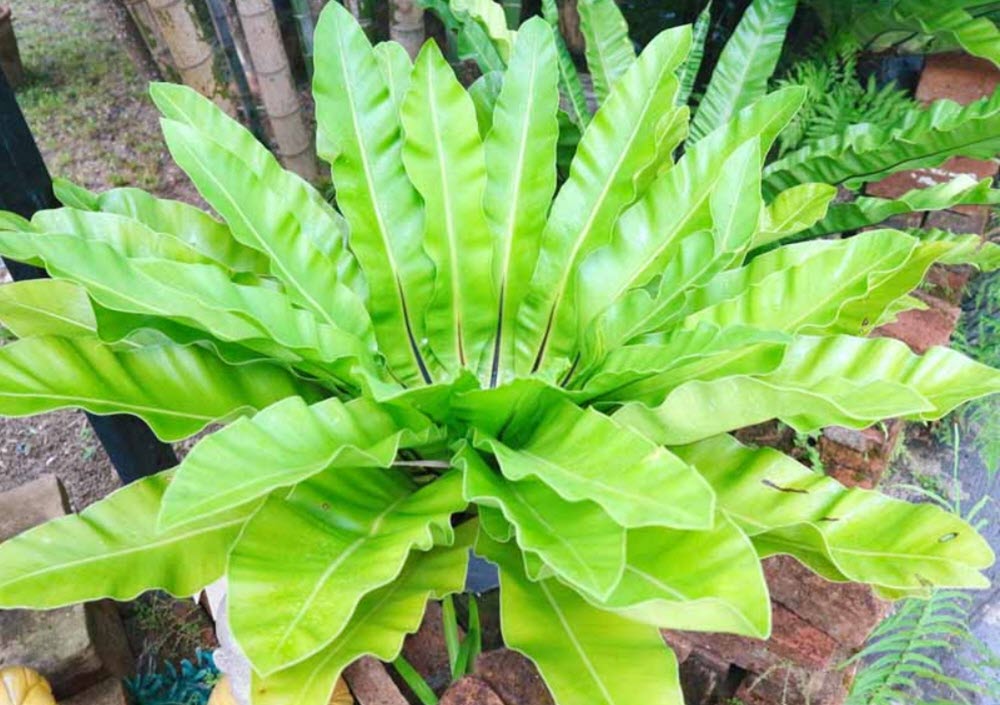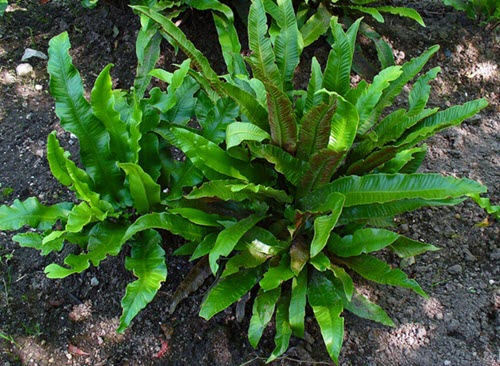Contents
The evergreen fern Hart´s Tongue is often grown as a potted plant and several cultivars are available in the trade. Many people like the fact that this fern can produce differently shaped blades on the same plant at the same plant, e.g. some blades will have undulated blade edges, some have frilled edges, some blades have a pointy tip, some blades have a crested tip, etc.

In suitable climates, Hart´s Tongue is also grown as a garden plant in shaded areas with sufficient moisture. Since it likes shade, it can be planted under trees, bushes and other shade-bringers in the garden. When it likes its environment, it can grow big and form large drifts. This fern is especially popular in limestone rock gardens and alpine gardens.
In English, hart is an archaic word for stag. The name Hart´s tongue is a reference to the supposed resemblance of this fern´s frond shape to a deer´s tongue.
Short info
Scientific name: Asplenium scolopendrium
Family: Aspleniaceae
Shape: bushy
Height 30-40 cm
Spread: 30-45 cm
Foliage: green
Watering: water moderately during the active growth period, and only sparingly during the rest period
Light: medium
Humidity: low
Temperature: 13-24°C for the active growth period, 10-13°C for the rest period
Description
Hart´s Tongue is an evergreen fern, where tufts of strap-like frond blades unfurl from a branching rhizome. The rhizome is covered in furry brown scales.
The stalks, which can be up to 25 cm long, are usually black at the base and then gradually become green.
The frond blades are green. When the fern grows outdoors, these blades can be up to 50 cm long. When the fern is kept as a potted houseplant, it is unusual for the frond blades to become longer than 25 cm.
The spore cases appear in a herringbone pattern.
Where does this fern grow in the wild?
Hart´s Tongue Fern is widely distributed in parts of Europe, Africa and Asia, and there are also scattered populations in eastern North America. In Europe, it is found in the central and southern parts. In Africa, it grows in the northwestern part of the continent. In Asia, it is present in places such as eastern Iran, Korea, Japan, and the island Sakhalin in eastern Russia.
Habitat
In the wild, Asplenium scolopendrium is typically fond in the vincinity of dolomite, which is a limestone rich in magnesium. This fern likes habitats that stay moist year round and is often seen growing at cave entrances, near sinkholes, at steep slopes with moist soil, and in wooded limestone ravines. Crevices, depressions, spray zones, shady cliff margins, and moisty moss mats are all beneficial environments for the A. scolopendrium.
Keeping Asplenium scolopendrium as a house or garden plant
During the part of the year when the days are short, Asplenium scolopendrium will rest, and it is important to keep this in mind since the recommended plant care is different for this period compared to the growth season when the days are longer.
Position and light
Asplenium scolopendrium like to grow in a shaded or partly shaded spots with medium light. Do not subject it to strong direct sunlight, since this can easily damage the fronds and make them yellow.
Soil
The ideal soil is humus-rich limestone soil that is slightly alkaline.
It should be kept moist but not wet. It is important that it drains well. If the soil doesn´t drain well enough, the roots will rot.
Temperature
The recommended temperature ranges are13-24°C for the active growth period (when the days are long) and 10-13°C for the rest period (when the days are short). When the temperature is above 18°C it becomes especially important to not allow the surrounding environment to dry out.
Watering
 Water moderately during the active growth period, and only sparingly during the rest period.
Water moderately during the active growth period, and only sparingly during the rest period.
When you water during the growht period, give the soil enough water to become moist throughout. Then, do not water again until at least one centimetre of the top soil is dry.
During the rest period, when the temperature is below 13°C, the fern should only be watered sparingly. Let the soil dry out half-way through before you give more water.
Regardless of time of the year, it is advisable to water in the morning and not water on the crown. Watering on the crown increases the risk of crown rot.
Nutrients
It is convenient to use liquid fertiliser. For potted hart´s tongue plants, we use a standard liquid fertilizer at half-strength during the growth period, and not at all during the resting period. If the potting medium is soil-based, feeding once a month is enough. If the potting-medium is peat-based, do two feedings per month.
For ferns growing outdoors, we apply cow manure in the spring, and then some liquid fertilizer at half-strength once a month throughout the growth period.
When should i repot?
Repot when the roots fill the pot. The best part of the year to repot is spring. When repotting, always plant the rhizomes vertically.
